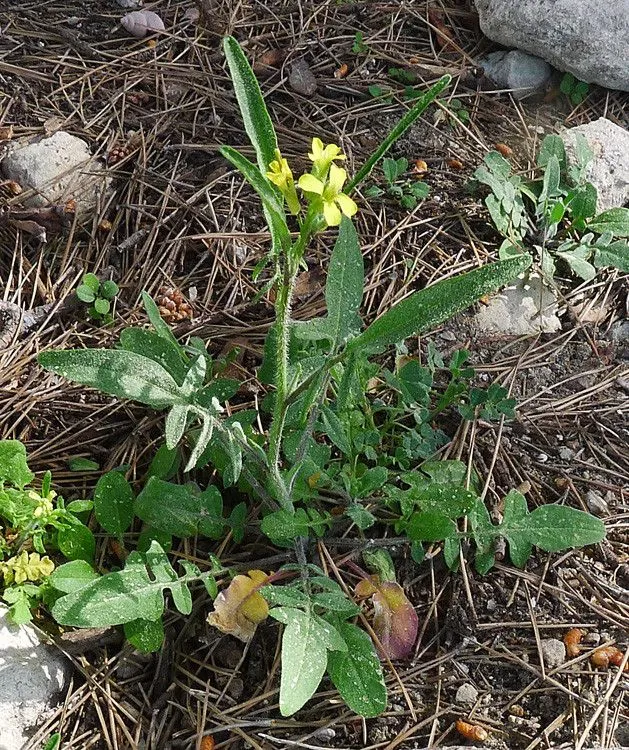
Author: L.
Bibliography: Cent. Pl. II: 24 (1756)
Year: 1756
Status: accepted
Rank: species
Genus: Sisymbrium
Vegetable: False
Observations: Macaronesia, Medit. to W. Himalaya
Oriental mustard, scientifically known as Sisymbrium orientale, is a noteworthy plant species belonging to the Brassicaceae family. This annual herb has captivated botanists and nature enthusiasts alike due to its widespread presence and adaptability across varied regions extending from Macaronesia and the Mediterranean to the western Himalayas.
The intriguing journey of Sisymbrium orientale in scientific literature began notably with its formal description by the eminent botanist Carl Linnaeus in 1756, where it was meticulously documented in the second volume of “Cent. Pl.” on page 24. This early recognition highlights the plant’s longstanding significance in botanical studies.
Characterized by its slender, branching stem and vibrant yellow flowers, the Oriental mustard thrives in a range of habitats, from rocky terrains to cultivated fields. Its ability to flourish in diverse climates has made it a resilient species, often seen as a pioneer plant that contributes to the ecosystem by providing food and shelter for various pollinators and insects.
The presence of Sisymbrium orientale across such a broad geographical stretch—from the temperate zones of the Mediterranean to the high-altitude ranges of the Himalayas—underscores its ecological versatility. This adaptability is a testament to the plant’s robust genetic makeup, enabling it to survive and propagate under different environmental pressures.
Not just interesting from a botanical perspective, Oriental mustard has also been observed for its practical applications. Historically, it has been utilized in traditional medicine and as a source of nutrients. The seeds of the plant are known for their mustard oil, which has culinary as well as medicinal uses in various cultures.
In summary, Sisymbrium orientale, or Oriental mustard, occupies a special place in the realm of botany and ecology due to its extensive distribution and ecological resilience. Its early documentation by Linnaeus marks the beginning of its long-standing recognition, while its functional versatility continues to contribute to its significance in both natural and human-influenced environments.
Swe: dagöga, hamnsolros, prairie solros, jordärtskocka, orientsenap
Eng: eastern rocket, indian hedge mustard, indian hedgemustard, oriental mustard, oriental rocket, wild mustard, oriental hedge mustard, eastern tumble mustard
Dan: jordskok, orientalsk vejsennep, purpur-solsikke
Nld: oosterse raket
Deu: orientalische rauke, ™stliche rauke
Lit: rytinė pikulė
Lav: austrumu žodzene
Ces: hulavník východný
Est: ida-unilook
Fra: sisymbre dorient, sisymbre d’orient
Cym: berwr dwyreiniol, roced y dwyrain
En: Oriental mustard, Oriental rocket, Eastern rocket, Indian hedge mustard, Wild mustard, Indian hedgemustard, Oriental hedge mustard, Eastern tumble mustard, Oriental Hedge-mustard, Indian hedge-mustard, Oriental hedgemustard
Ar: سليخ (سَليخ)
Ca: Sisimbri oriental
Cs: Hulavník východný
Da: Jordskok, Orientalsk vejsennep, Purpur-solsikke
Nl: Oosterse raket
Et: Ida-unilook
Fr: Sisymbre dorient, Sisymbre d’Orient, Vélar d’Orient
De: Orientalische Rauke, ™stliche Rauke, Östliche Rauke
He: תודרה מזרחית
It: Erba-cornacchia orientale
Lv: Austrumu žodzene
Lt: Rytinė pikulė
Es: Erismo oriental
Sv: Orientsenap, Dagöga, Hamnsolros, Prairie solros, Jordärtskocka
Cy: Berwr Dwyreiniol, Roced y Dwyrain
Taken Apr 14, 2015 by Tela Botanica − Liliane Roubaudi (cc-by-sa)
Taken Jun 23, 2015 by Tela Botanica − Ferdinand von Praun (cc-by-sa)
Taken Nov 29, 2020 by Darren Giddins (cc-by-sa)
Taken Nov 29, 2020 by Darren Giddins (cc-by-sa)
Taken Mar 27, 2019 by Ricardo Lemaur (cc-by-sa)
© copyright of the Board of Trustees of the Royal Botanic Gardens, Kew.
© copyright of the Board of Trustees of the Royal Botanic Gardens, Kew.
© copyright of the Board of Trustees of the Royal Botanic Gardens, Kew.
Taken Mar 17, 2022 by Jean Burger (cc-by-sa)
Taken Oct 1, 2020 by kafaktor (cc-by-sa)
Taken Jul 10, 2019 by kevin (cc-by-sa)
Taken Apr 24, 2011 by Tela Botanica − Marie PORTAS (cc-by-sa)
Taken Jun 23, 2015 by Tela Botanica − Ferdinand von Praun (cc-by-sa)
Taken Apr 14, 2015 by Tela Botanica − Liliane Roubaudi (cc-by-sa)
Taken Apr 14, 2015 by Tela Botanica − Liliane Roubaudi (cc-by-sa)
Taken Apr 14, 2015 by Tela Botanica − Liliane Roubaudi (cc-by-sa)
Taken Apr 14, 2015 by Tela Botanica − Liliane Roubaudi (cc-by-sa)
Taken Apr 14, 2015 by Tela Botanica − Liliane Roubaudi (cc-by-sa)
Taken Apr 4, 2015 by EOL − Jesse Rorabaugh (cc-by)
Taken Apr 3, 2015 by EOL − Jesse Rorabaugh (cc-by)
Taken Dec 4, 2014 by EOL − Jon Sullivan (cc-by-nc)
Taken Apr 14, 2013 by Tela Botanica − Bertrand BUI (cc-by-sa)
Taken Apr 14, 2015 by Tela Botanica − Liliane Roubaudi (cc-by-sa)
Taken May 22, 2015 by Tela Botanica − Carturan Maurizio (cc-by-sa)
Taken Apr 12, 2012 by Tela Botanica − Bertrand BUI (cc-by-sa)
Taken Apr 14, 2015 by Tela Botanica − Liliane Roubaudi (cc-by-sa)
Taken Apr 9, 2009 by Tela Botanica − Mathieu MENAND (cc-by-sa)
Taken Apr 12, 2012 by Tela Botanica − Bertrand BUI (cc-by-sa)
Growth habit: Forb/herb
Ph maximum: 8.0
Ph minimum: 7.5
Light: 8
Atmospheric humidity: 5
Soil nutriments: 8
Family: Myrtaceae Author: (F.Muell.) K.D.Hill & L.A.S.Johnson Bibliography: Telopea 6: 402 (1995) Year: 1995 Status:…
Family: Rubiaceae Author: Pierre ex A.Froehner Bibliography: Notizbl. Bot. Gart. Berlin-Dahlem 1: 237 (1897) Year:…
Family: Sapindaceae Author: Koidz. Bibliography: J. Coll. Sci. Imp. Univ. Tokyo 32(1): 38 (1911) Year:…
Family: Asteraceae Author: A.Gray Bibliography: Pacif. Railr. Rep.: 107 (1857) Year: 1857 Status: accepted Rank:…
Family: Fabaceae Author: Medik. Bibliography: Vorles. Churpfälz. Phys.-Ökon. Ges. 2: 398 (1787) Year: 1787 Status:…
Family: Aspleniaceae Author: (Cav.) Alston Bibliography: Bull. Misc. Inform. Kew 1932: 309 (1932) Year: 1932…